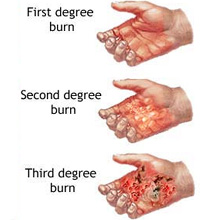An injury that can damage or kill skin cells due to exposure to heat, fire, chemicals or electricity is called a burn. The severity of the burn is based on three factors: the depth of the burn, the area of the burn and the location of the burn.
Severity of the burns increases if the area of the burn is too large and/or if it has affected the eyes, nose, neck, face, hands, feet, major joints, buttocks or genitals, despite the depth of the burn. Burns in the nose or neck may cause swelling or inflammation which can drastically constrict the airways causing difficulty in breathing. Burns can cause blurred vision or even blindness when the eyes are taxed. Burns are often difficult to heal and leave scars so it is essential that you take the condition more seriously and seek for medical help if required.
In order to distinguish a severe burn from a mild one, it is important that you check the extent of the burn before you decide to call for medical help. The depth of the burn refers to the following aspects:
1. First degree burns
First degree burns are often superficial and do not require medical help. This is the least serious burn as only the outer surface of the skin is damaged. You can suspect a first degree burn through the following symptoms:

- Skin turns red
- Swelling
- Pain
First degree burns can be treated as minor burns but make sure you consider the other factors i.e. area and location of the burn as well. If the area of the burn is equivalent to the area of the palm of your hand and has affected the hands, feet, major joint, face, buttocks or genitals, it is essential that you call for emergency medical help.
2. Second degree burns
Second degree burns are more severe compared to first degree burns and often refer to burns that have damaged the outer layer and the second layer i.e. the dermis, of the skin. Symptoms include:
- Intense red skin
- Wet, weeping skin
- Blisters
- Severe swelling
- Severe pain
Severity can be further investigated by considering area and location. If the burn is of more than 3 inches and/or located on the hands, face, feet, major joint, genitals or buttocks, call for medical help immediately.
3. Third degree burns
These are the most severe burns and should be treated with extreme caution. The burn damages all layers of the skin and even the fat, muscle and bone may be affected as well. Symptoms and signs include:
- Black, deep red, white and/or dry appearance of dead skin
- Difficulty in breathing
- Carbon monoxide poisoning caused by inhaling smoke
There will be no pain because the skin loses sensation as the nerve endings are damaged.
Treatment
For minor burns that have not severely affected a large area (more than 3 inches) of the body or any of the vital body parts as mentioned above, the following procedures can be taken:
- Alleviate the pain by cooling the burn: Bring the burned area under cool running water for about 15 minutes until the pain is reduced. You may also cool the burn by immersing the area in cool water or by giving it cold compresses. Do NOT put ice or cold water on the burn. Cooling the burn reduces swelling and inflammation by sapping the heat from the skin.
- Use a sterile gauze bandage to wrap the burn. Make sure you do not use cotton balls or any form of material that may leave a residue on the burn. Wrap the bandage around the burn loosely and make sure you do not apply too much pressure on the burn. This will protect blistered skin from air, pain and bacteria.
- Take aspirin or any other over-the-counter pain relievers to reduce pain. Children recovering from viral infections or chicken pox should not be given aspirin. Medical treatment should be done by a doctor in such cases.
Do not use home remedies such as butter, oil, toothpaste or egg whites to heal the burn as this may cause infections. Do not break blisters either. Use sunscreen on the healed area throughout the year.
For major burns
For major burns, call emergency medical help immediately. Till help arrives, follow these steps:
- Do not remove clothing that has been burnt. However, make sure the person is not in contact with material that is on fire and keep him away from smoke. Allow him to rest outside where there is fresh air
- Do not treat large, severe wounds with cold water. Cold water may drastically drop the body’s normal temperature causing hypothermia and may impair the blood circulation leading to shock
- If there are no signs of circulation, begin CPR
- Elevate the burnt parts above heart level, if possible
- Cover the burn with a cool, moist, clean or sterile bandage or cloth
Burns are vulnerable to tetanus. Therefore, it is vital that you get a tetanus shot every 10 years.
Learn More about Burns
To learn more about managing, recognizing, differentiating and treating burns take a first aid training course through a recognized provider near you. For a list of quality providers throughout Canada visit our training locations page.
Additional Video on Burns
http://www.youtube.com/watch?v=Bp5yGGaJ39U